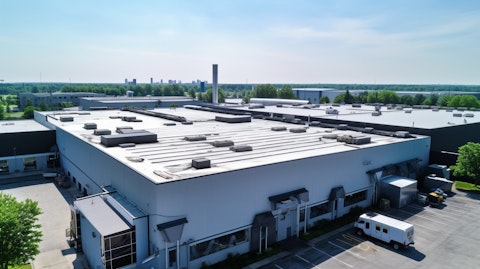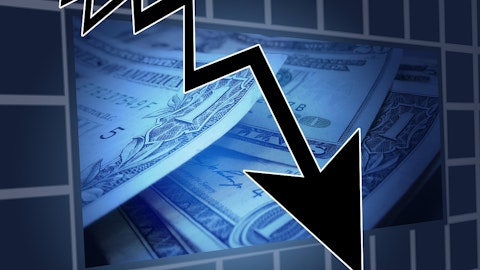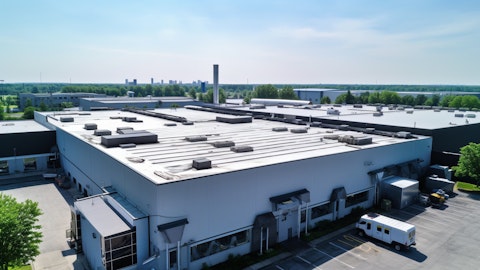RPM International Inc. (NYSE:RPM) Q2 2024 Earnings Call Transcript January 4, 2024
RPM International Inc. misses on earnings expectations. Reported EPS is $1.22 EPS, expectations were $1.23. RPM isn’t one of the 30 most popular stocks among hedge funds at the end of the third quarter (see the details here).
Operator: Good morning, and welcome to the RPM International Fiscal Second Quarter 2024 Earnings Conference Call. All participants will be in listen-only mode. [Operator Instructions] After today’s presentation, there will be an opportunity to ask questions. [Operator Instructions] Please note, this event is being recorded. I would now like to turn the conference over to Matt Schlarb, Senior Director of Investor Relations. Please go ahead.
Matthew Schlarb: Thank you, Gary, and welcome to RPM International’s conference call for the fiscal 2024 second quarter. Joining today’s call are Frank Sullivan, RPM’s Chair and CEO; Rusty Gordon, Vice President and Chief Financial Officer; and Michael Laroche, Vice President, Controller and Chief Accounting Officer. The call is also being webcast and can be accessed live or replayed on the RPM website at www.rpminc.com. Comments made on this call may include forward-looking statements based on current expectations that involve risks and uncertainties, which could cause actual results to be materially different. For more information on these risks and uncertainties, please review RPM’s reports filed with the SEC. During this conference call, references may be made to non-GAAP financial measures.
To assist you in understanding these non-GAAP terms, RPM has posted reconciliations to the most directly comparable GAAP financial measures on the RPM website. Also, please note that our comments will be on an as-adjusted basis and all comparisons are to the second quarter of fiscal 2023, unless otherwise indicated. We have provided a supplemental slide presentation to support our comments on the call. It can be accessed in the Presentation and Webcasts section of the RPM website at www.rpminc.com. Additionally, as a reminder, certain businesses in Asia Pacific that were previously part of the Construction Products Group are now being managed and reported under the Performance Coatings Group effective June 1, 2023. As a result, all references to CPG and PCG today reflect the updated structure.
The recast businesses generate approximately $100 million in annual sales and this change has no impact on consolidated results. At this time, I would like to turn the call over to Frank.
Frank Sullivan: Thank you, Matt, and welcome to everybody joining us on our call today. I’ll start with an overview of our second quarter performance, then I’ll turn the call over to Mike Laroche to discuss the financials in more detail. Matt will then provide an update on the balance sheet and the recent opening of an R&D facility, and Rusty will cover our outlook. At the end of the prepared remarks, we’ll be pleased to answer your questions. Starting with our second quarter results on Slide 3. We generated our eight consecutive quarter of record sales and adjusted EBIT. While revenue growth was slightly positive because of softness in certain end markets, we continued our trend of good margin expansion led by our MAP 2025 initiatives.
This resulted in double-digit adjusted EBIT growth, which is squarely in the guidance we provided and in addition to the strong growth we generated in the prior year quarter. The MAP 2025 initiatives were also a key reason we generated all-time record cash flow of $408.6 million from operating activities during the quarter. Enhanced collaboration between commercial and operational functions, means we are now able to respond to customer demand more quickly without having to build large safety stocks as we have done in the past and this is having a positive impact on working capital. Through the first six months of fiscal 2024, we generated $767.8 million of cash flow from operating activities, which surpassed our previous all-time fiscal year record.
Turning to Slide 4. Sales were led by our Construction Products Group and Perform — and Performance Coatings segment, which benefited from their focus on repair and maintenance as well as their positioning to serve strong demand for infrastructure, re-shoring, and high-performance buildings with their engineered solutions. Volumes declined in the Consumer and Specialty Products Group segments as demand in DIY and especially OEM end-markets, particularly those with residential exposure remained soft. Both of the segments have been pressured for the past year as individuals have focused their spending on travel and entertainment and existing home turnover has been at a multi-decade low. Pricing was positive in all segments and helped offset lower overall volumes.
Despite these challenging end markets, we achieved another quarter of strong margin expansion led by our MAP 2025 initiatives. Margin expansion was strongest at the Construction Products Group and the Performance Coatings Group, which both generated positive volume during the quarter. This demonstrates the potential for our MAP 2025-enabled margin expansion in our businesses underperforming when volumes begin to grow again. As a reminder, second quarter growth was in addition to a strong quarter in the prior year period. The two-year stack growth for sales and adjusted EBIT was 9.3% and 50.6% respectively. Moving to Slide 5, I’m pleased to report that the changes we recently made to our management structure are showing good progress. In Europe, new management teams have focused their sales strategy and implemented MAP 2025 initiatives to grow sales and expand margins.
In Africa, Middle East, and Asia Pacific, which are now aligned under our Performance Coatings Group management, our businesses are realizing the potential of increased collaboration in our operations. Sales in Africa, Middle East grew 13%, and Asia-Pacific increased 6.4%, and we’re realizing operational synergies that are leading to even greater profitability growth. Overall, I’m proud of our associates’ performance in the second quarter. We’re executing exceedingly well in the things that we can control and the hard work we are doing on MAP 2025 initiatives is enabling collaboration, efficiencies, and cash flow to benefit us now. And I’m optimistic that we have even greater opportunities in the future. I’d now like to turn the call over to Matt Schlarb to cover our financials — I’m sorry, Mike Laroche to cover our financial results in more detail, Mike?
Michael Laroche: Thanks, Frank. Starting on Slide 6. Consolidated sales increased slightly as positive volumes at the Construction Products Group and Performance Coatings Group, higher pricing, and favorable FX, were offset by end-market weakness in Consumer and the Specialty Products Group. MAP 2025 benefits, including the commodity cycle drove 320 basis points of gross margin improvement. Improved fixed cost leverage at the Construction Products Group and the Performance Coatings Group also contributed to gross margin expansion. SG&A as a percentage of sales increased during the quarter as we reinvest MAP savings in long-term growth initiatives and to incentivize the sale of higher margin products and services. Inflation in areas like wages, benefits, and health care expenses added to the increase in SG&A.
Expense reduction actions taken at the end of fiscal 2023 helped to mitigate the increase and we are taking additional actions to limit SG&A increases in the second half of 2024. Adjusted EBIT grew — adjusted EPS grew 10.9% to $1.22 which is a second quarter record and was driven by adjusted EBIT growth with an increase in interest rates, being offset by debt pay-downs. Turning to the Construction Products Group results on Slide 7. They achieved record Q2 sales led by concrete admixtures which continued to benefit from reshoring and infrastructure projects, as well as market-share gains. The segment also benefited from increased demand for high-performance buildings, both new and renovations, with particular strength in sealants and wall cladding.
As Frank mentioned, Europe is benefiting from a more focused sales strategy, and this includes CPG which is our largest segment in Europe. Adjusted EBIT increased to a second quarter record led by higher sales, improved fixed-cost leverage, and MAP 2025 benefits. As a result of the strong financial performance, variable compensation increased and was partially offset by expense reduction actions put in place at the end of fiscal 2023. On Slide 8, the Performance Coatings Group achieved record second quarter sales, driven by strong demand for the segment’s engineered turnkey flooring systems due to heavy activity in reshoring capital projects and market-share gains. The businesses in Africa, Middle East and Asia Pacific were all recently aligned under PCG management, contributed to the segment’s growth.

This volume growth resulted in improved fixed-cost leverage, and along with MAP 2025 benefits, generated all-time record adjusted EBIT during the quarter. Moving to Slide 9, Specialty Products Group sales declined as specialty OEM demand remained weak, particularly in the end-markets that have exposure to residential housing, including furniture, doors, windows, and cabinets. The divestiture of the non-core furniture warranty business last fiscal year, reduced sales and the segment also faced challenging comparisons to the prior year period when the disaster restoration business benefited from the response to Hurricane Ian in Florida, which did not repeat in fiscal 2024. The reduced volumes resulted in unfavorable deleveraging and adjusted EBIT declines, which were partially offset by expense reduction actions implemented at the end of fiscal 2023.
SPG also continued strategic investments in long-term growth initiatives, which weighed on adjusted EBIT margins. Matt will talk about one of those growth investments shortly. Please note that adjusted EBIT excludes a $4 million expense related to an adverse legal ruling for a divested business. Turning to Slide 10, the Consumer Group was pressured by soft takeaway at retail stores from DIY customers as they focused their time and spending on travel and entertainment rather than projects around the house and as housing turnover hit multi-year lows. Certain retailers were also more cautious with inventory levels, which pressured volumes. Market-share gains, strength in international markets, and increased pricing to catch up with prior material and current labor inflation helped limit the volume declines.
As a reminder, Consumer faced challenging comparisons as sales increased 15.3% in the prior year period. Despite challenging end markets, Consumer still generated record second quarter adjusted EBIT. This was achieved primarily due to MAP 2025 benefits and strength in international markets and was in addition to strong growth in the prior year when adjusted EBIT increased over 180%. Now I’d like to turn the call over to Matt, who will cover the balance sheet, cash flow, and provide an investment update.
Matthew Schlarb: Thank you, Mike. Moving to Slide 11, we continue to make significant progress on improving working capital, primarily through lower inventories, which decreased $287 million from prior year levels. This combined with our improved profitability, resulted in all-time record cash flow from operating activities of $408.6 million in the second quarter. As Frank mentioned, our cash flow in the first six months of the fiscal year has surpassed our previous 12-month fiscal year record. Year-to-date, we have returned $113.3 million of cash to shareholders through dividends, and in October, we achieved our 50th consecutive year of increasing our dividend, an accomplishment only 41 other publicly traded companies can claim.
This sustained dividend growth has been enabled by our strategic balance, our focus on repair and maintenance, and our entrepreneurial spirit, all of which help us grow throughout economic cycles. We have also returned additional cash to shareholders through share repurchases which total $225 million to date. Finally, we’ve continued to repay debt and at the end of the second quarter of 2024, total debt is $592 million lower than the prior year. These debt repayments have helped mitigate the impact of rising rates on interest expense and provided flexibility to take advantage of future opportunities. Moving to Slide 12, as Mike mentioned, our segments are making investments to accelerate long-term growth. We’d like to highlight one of those investments, the RPM Innovation Center of Excellence.
We recently celebrated the ribbon cutting on this new state-of-the-art facility located in Greensboro, North Carolina. This facility is the first of its kind at RPM, where multiple businesses can collaborate and share resources to help drive innovation. This is particularly important for some of our smaller businesses that do not have the scale or local talent to run a comprehensive R&D led by themselves. Additionally, the Innovation Center of Excellence serves as a showcase to customers, where they can visit and see first-hand our ability to find solutions to their challenges. Also, by sharing resources, we are eliminating the need to have duplicative equipment and multiple labs which will control long-term expenses. The facility is being overseen by Specialty Products Group because many of their businesses are prime candidates to utilize it and we already have businesses from all four segments collaborating there today.
Now, I’d like to turn the call over to Rusty, to cover the outlook.
Russell Gordon: Thanks, Matt. And before we start, just to clarify, the year-to-date share repurchases are $25 million, just so that’s clear. Now I’ll go on with the outlook. On Slide 13, you can see our third quarter outlook, which as a reminder, is our seasonally slowest quarter. Market trends in Q3 are expected to be similar to Q2 as strength in CPG and SPG, international markets, and market-share gains are offset by weakness in DIY and specialty OEM markets. The expected result is flat sales to the record prior year period. On consolidated adjusted EBIT — excuse me, our consolidated adjusted EBIT growth is expected to accelerate and increase 25% to 35% over the prior year record results, driven by MAP 2025 benefits, including in Europe, which is an area of focus for us, and less challenging prior year comparisons.
This adjusted EBIT outlook is inclusive of growth and efficiency, investments we are making in our businesses, and at the corporate level, which will weigh on short-term margins. I’ll add that we are also taking actions to limit SG&A growth in the second half of the year. By segment, CPG and PCG are expected to continue to benefit from their focus on repair and maintenance, and from continued spending on infrastructure, high-performance building, and reshoring projects. Market-share gains are also expected to contribute to sales growth. We are expecting sales in both segments to increase in the mid-single-digit range. In SPG, we have not seen an inflection point in demand, with housing turnover hovering near multi-year low levels. As a result, we expect sales to decline in the mid-teen percentage range.
In Consumer, we expect sales to decline by low-single-digits as soft DIY demand is expected to be partially offset by market-share gains. Moving to our full year outlook on Slide 14, we are lowering our sales expectations for the year due to lingering softness in the DIY and specialty OEM markets. Our new outlook for the year is, sales growth in the low-single-digit range versus the prior expectation of mid-single-digit growth. Despite the reduction in the sales outlook, we continue to make good progress achieving MAP 2025 benefits. And as a result, are affirming our adjusted EBIT outlook of growth in the low-double-digit to mid-teen range. This includes benefits we are capturing from the commodity cycle as overall raw material prices decline, while we maintain pricing.
This concludes our prepared remarks. We will now be pleased to answer your questions.
Operator: We will now begin the question-and-answer session. [Operator Instructions] Our first question today comes from John McNulty with BMO Capital Markets. Please go ahead.
See also 12 Best Tech Stocks To Buy According to Billionaire Ken Griffin and Wall Street Analysts Just Trimmed Price Targets for These 10 Stocks.
Q&A Session
Follow Rpm International Inc (NYSE:RPM)
Follow Rpm International Inc (NYSE:RPM)
Frank Sullivan: Hi, John.
John McNulty: Good morning. Hey, Frank. Good morning. So, I wanted to dig into Consumer a little bit. So, it was down a little bit north of 5%. Your original expectations forward (ph) in the quarter was up low-single digits. It doesn’t look like it was price, because you’ve got pricing across all the businesses. So I guess, can you help us peel back Young and a little bit on volumes, how much was kind of — was it down on just Consumer takeaway verse — versus some of the destocking that you’re seeing? And then also, can you speak to some of the share gain offset that you had? Maybe quantify that a little bit for us as well?
Frank Sullivan: Sure. On a consolidated basis, price in the quarter was up slightly less than 2% and so that should give you a sense, that’s a little bit less than Consumer, and it’s just month-after-month of negative Consumer takeaway. I would note that we are outperforming our directly comparable Consumer paid peers in terms of volume. But it’s been a consistently minus low-single-digit, minus mid-single-digit Consumer POS over the last eight to nine months, and we don’t see that changing until possibly this spring.
John McNulty: Okay. And when you think about some of the destocking that you’ve seen in the business, because I think you highlighted, at a couple of retailers that was an issue. As far as where inventories are, or at some of these bigger retailers, I guess, would you say they’re kind of about where they normally would be going into the beginning of the spring paint season, are they below? I guess, how would you characterize that?
Frank Sullivan: I think they’re back to normal. You’ve seen a significant readjustment in supply chains, both with our customers and also as we noted within RPM. Last — this time last year, we talked about our efforts to really focus on operating efficiency and cash flow, and that we would do so at the expense of profitability in terms of overhead absorption, and that’s happened throughout the last 12 months, but the execution of the RPM people in this quarter is exceptional. We have reduced debt by almost $600 million bucks over the last 12 months. We generated record levels of cash flow on a six-month period. Our cash conversion cycle versus one year ago is almost improved by 30 days. And so, the things that we can control are being executed very well.
I think we’re really happy with that. As you’re seeing in the third quarter expectation, to be able to generate a 25% to 35% EBIT growth on what essentially is the same sales as last year, gives you a good sense of the improvements we’ve made.
John McNulty: Got it. No. It makes sense. And actually maybe to that, if I can squeeze one last one in. You saw some notable margin lift despite a pretty soft volume environment. I guess, can you help us to think about how much of that was from the price versus raws benefit versus some of the MAP improvements? And then I guess maybe the third bucket would be just general mix improvements, but I guess, can you help us to parse out where some of that real improvement was coming in?
Frank Sullivan: Sure. We went cost price mix positive in most of our businesses starting in the summer and we’ll be cost price mix positive relative to raw material inflation and our price increase efforts in Consumer in the third quarter. I’ll just use Consumer as an example. Over a 18-month to 24-month period, we absorbed about $500 million of higher cost raw material, labor, and things like that. And as is normal in these cycles, we lose margin, spend time catching up, and we will be cost price mix margin positive in Consumer for the first time in Q3. And you can see we’ve been that way in PCG and CPG going back to the beginning of the summer. I think you can also see the strong leverage when we’ve got volume in the PCG and CPG performance and we would expect the same in our Specialty Products Group and Performance Coatings — I’m sorry, Consumer Group, once we start generating positive unit volume.
John McNulty: Got it. Thanks very much. Appreciate the color, Frank.
Frank Sullivan: Thank you.
Operator: The next question is from David Huang with Deutsche Bank. Please go ahead.
Frank Sullivan: Good morning.
David Huang: Hi. Good morning. I guess, on construction, can you talk about the trends you are seeing by end markets? And I guess, specific to infrastructure and reshoring, are you seeing any project delays, either because of slower government approval or people are just delaying their projects into 2024 because of lower construction cost expectations?
Frank Sullivan: We have not seen much in the way of project delays. The project delays that we would experience tend to be weather-related in the — particularly in the Construction Products Group, and so far, we’re in pretty good shape there. It actually feels like — and some of this is what happens when the government commits a trillion dollars of infrastructure and other stimulus, that there is a manufacturing renaissance happening. And so, while we are specified on some major onshoring projects, particularly in the technology area, and that’s coming, you’re seeing the follow-on of that with suppliers. And so we’re in a pretty good space with, for instance, stonehard flooring, our Carboline high-performance coatings, Euclid Chemical and admixtures, a lot of the construction chemicals business.
Also, just as a reminder, our Tremco roofing business is about $800 million, and 95% of that is reroofing and/or renovation. And so we’re not very exposed to the commercial construction cycle there. And so, that’s doing really well. Lastly, we have been moving with our WTI business into some asset management areas, including an acquisition of a couple years ago, Pure Air, and that is the refurbishment and renovation of commercial HV and industrial HVAC systems, and that business is showing some really strong growth as well.




